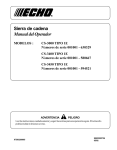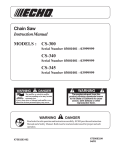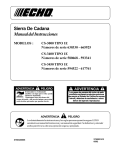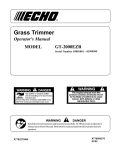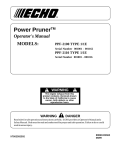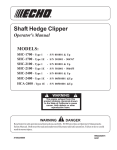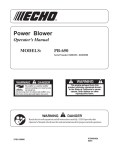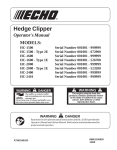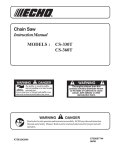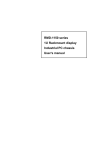Download Echo CS-3000 User's Manual
Transcript
Chain Saw Operator’s Manual MODELS : CS-3000 TYPE 1E Serial Number 001001 - 630329 CS-3400 TYPE 1E Serial Number 001001 - 580667 CS-3450 TYPE 1E Serial Number 001001 - 594521 WARNING DANGER Read rules for safe operation and instructions carefully. ECHO provides an Operator’s Manual and an Engine Operator’s Manual. Both must be read and understood for proper and safe operation. X7503200005 99922202726 05/02 RULES FOR SAFE OPERATION A. Kickback Safety Precaution for Chain Saw Users 2. Keep a good firm grip on the saw with both hands, the right hand on the rear handle, and the left hand on the front handle, when the engine is running. Use a firm grip with thumbs and fingers encircling the chain saw handles. A firm grip will help you reduce kickback and maintain control of the saw. Dont’ let go. WARNING! KICKBACK may occur when the nose or tip of the guide bar touches an object, or when the wood closes in and pinches the saw chain in the cut. Tip contact in some cases may cause a lightning fast reverse REACTION, Kicking the guide bar up and back towards the operator, pinching the saw chain along the top of the guide bar rapidly back towards the operator. Either of these reactions may cause you to lose control of the saw which could result in serious personal injury. 3. Make sure that the area in which you are cutting is free from obstructions. Do not let the nose of th guide bar contact a log, branch, or any other obstruction which could be hit while you are operating the saw. Do not rely exclusively upon the safety devices built into your saw. As a chain saw user, you should take several steps to keep your cutting jobs free from accident or injury. 4. Cut at high engine speeds. 1. With a basic understanding of kickback, you can reduce or eliminate the element of surprise. Sudden surprise contributes to accidents. 6. Follow manufacturer’s sharpening and maintenance instructions for the saw chain. 5. Do not overreach or cut above shoulder height. 7. Only use replacement bars and chains specified by the manufacturer or the equivalent. B. Other Safety Precautions 11. Shut off the engine before setting the chain saw down. 1. Do not operate a chain saw with one hand! Serious injury to the operator, helpers, bystanders, or any combination of these persons may result from one-handed operation. A chain saw is intended for two-handed use. 12. Use extreme caution when cutting small size brush and saplings because slender material may catch the saw chain and be whipped toward you or pull you off balance. 2. Do not operate a chain saw when you are fatigued. 13. When cutting a limb that is under tension, be alert for springback so that you will not be struck when the tension in the wood fibers is released. 3. Use safety footwear; snug-fitting clothing; protective gloves; and eye, hearing and head protection devices. 4. Use caution when handling fuel. Move the chain saw at least 10 feet (3 m) from the fueling point before starting the engine. 14. Keep th handles dry, clean, and free of oil or fuel mixture. 5. Do not allow other persons to be near the chain saw when starting or cutting with the chain saw. Keep bystanders and animals out of the work area. 16. Do not operate a chain saw in a tree unless you have been specifcally trained to do so. 15. Operate the chain saw only in well-ventilated areas. 17. All chain saw service, other than the items listed in the operator’s manual maintenance instructions, should be performed by competent chain saw service personnel. (For example, if improper tools are used to remove the flywheel or if an improper tool is used to hold the flywheel in order to remove the clutch, structural damage to the flywheel could occur and could subsequently cause the flywheel to burst.) 6. Do not start cutting until you have a clear work area, secure footing, and a planned retreat path from the falling tree. 7. Keep all parts of your body away from the saw chain when the engine is running. 8. Before you start the engine, make sure that the saw chain is not contacting anything. 18. When transporting your chain saw, use the appropriate gude bar scabbard. 9. Carry the chain saw with the engine stopped, the guide bar and saw chain to the rear, and the muffler away from your body. 19. Spark arrester mufflers approved to SAE Standard J335b are Standard on ECHO Chain saws to reduce the possibility of forest fires. Do not operate the chain saw with a loose or defective muffler. Do not remove the spark arrester screen. 10. Do not operate a chain saw that is damaged, improperly adjusted, or not completely and securely assembled. Be sure that the saw chain stops moving when the throttle control trigger is released. 2 CONTENTS Page Rules for Safe Operation .................................................................................................................. 2 Technical Data ................................................................................................................................. 4 Nomenclature of Parts ...................................................................................................................... 5 Preparation for Use .......................................................................................................................... 6 Operation ......................................................................................................................................... 7 Cutting Instructions ........................................................................................................................... 9 Maintenance and Care ................................................................................................................... 13 Chain and Guide Bar Combinations ............................................................................................... 14 Setting the Saw Chain .................................................................................................................... 15 Troubleshooting .............................................................................................................................. 16 Storage .......................................................................................................................................... 17 Correct Use of Chain Brake ........................................................................................................... 18 TECHNICAL DATA C S -3000 TYP E 1-E C S -3000 D i mensi on i nch Wei ght P ower head, dry E ngi ne Type kg C S -3450 cc 380 x 230 x 245 10.2 x 9.1 x 8.7 15.0 x 9.1 x 9.6 3.2 (7.1 lb) Wi thout chai n and gui de bar 3.3 (7.3 lb) Wi thout chai n and gui de bar 3.4 (7.5 lb) Wi thout chai n and gui de bar 33.4 (2.03 cu.i n.) D i aphragm type Flywheel magneto : C D I system C HA MP ION C J-7Y or NGK B P M 7A Recoi l starter A utomati c centri fugal clutch 50:1 rati o wi th E C HO brand two-stroke oi l. 89 octane unleaded. D o not use fuel contai ni ng methyl alcohol, more than 10% ethyl alcohol or 15% MTB E . li ter B ar and chai n Tank C apaci ty 260 x 230 x 220 30.1 (1.83 cu.i n.) Mi xture rati o Tank C apaci ty Gui de bar and saw chai n C S -3400 A i r-cooled, two-stroke, si ngle cyli nder D i splacement C arburetor Magneto S park P lug S tarter P ower transmi ssi on Oi l C S -3450 TYP E 1-E L xW xH mm Fuel C S -3400 TYP E 1-E 0.25 (8.6 fl oz U.S .) E C HO bar and chai n oi l (or motor oi l) li ter 0.15 (5 fl. oz. U.S .) S ee page 14 for B ar and C hai n techni cal data. Lubri cati on S tandard features A djustable automati c oi l pump Top Handle C onveti onal handle Rear hand guard Front hand guard, A nti -vi brati on devi ce, Throttle control lockout, C hai n brake, C hai n catcher, S part arrester muffler * Technical data subject to change without notice. 3 NOMENCLATURE OF PARTS CS-3000, CS-3400 1. Hand guard (Chain brake actuating lever) 6. Air cleaner cover 11. On / Off switch 7. Purge bulb 12. Rear handle guard 2. Throttle control lockout 8. Guide bar 13. Fuel tank cap 3. Throttle control trigger 9. Saw chain 14. Pull starter 4. Sprocket guard 10. Front handle 15. Oil tank cap 5. Chain catcher 16. Throttle control latch 17. Tip guard CS-3450 4 PREPARATION FOR USE The machine is delivered with guide bar and saw chain separated. Install guide bar and chain as follows. Guide bar Saw chain Holes GUIDE BAR AND SAW CHAIN • Unscrew two nuts and remove sprocket guard. • Mount bar and slide toward sprocket to make saw chain installation easier. • Install chain as shown with cutters facing forward. • Ensure that tensioner fits into bar hole. • Install sprocket guard tighten nuts finger tight. Guide bar Chain tensioner ADJUSTMENT, CHAIN TENSION Direction to tension the chain • Turn the adjuster screw clockwise until the chain touches the bottom of the bar. • Hold the bar nose up and tighten the chain until there is no clearance between the bar and chain tie straps. • Tighten both nuts with the bar nose held up to eliminate clearance. • Pull the chain around the bar by hand. Loosen the adjustment if you feel tight spots. • Start the engine and run at low speed. Stop and readjust if necessary. Tensioner adjusting screw UP CAUTION 1. All adjustments should be made cold. 2. Always wear gloves when working on chain. 3. Do not operate with a loose chain. Sprocket guard 5 FUEL AND LUBRICANT FUEL STATEMENT GASOLINE - Use 89 Octane (R+M/2) gasoline or gasohol known to be good quality. Gasohol may contain maximum 10% ethyl (grain) alcohol or 15% MTBE (methyl tertiary-butyl ether). Gasohol containing methy (wood) alcohol is not approved. Oil OIL - ECHO brand premium two-stroke 50:1 oil is preferred. Mix oil and gasoline/gasohol according to instructions on the oil container label. Gasoline 50 MIXING - Follow directions on the oil container. Fuel Mix Chart 50:1 IMPORTANT Stored fuel ages. Do not mix more fuel than you expect to use in thirty (30) days, ninety (90) days when a fuel stabilizer is added. Stored two-stroke fuel may separate. ALWAYS shake fuel container thoroughly before each use. CHAIN LUBRICANT • Proper lubrication of the chain while in operation reduces friction between the chain and the guide bar to a minimum and assures a longer service life. • use bar and chain oil of high quality for this purpose. • Do not use used or reclaimed oil to avoid various oiler problems. • Use ECHO bar and chain oil. • When ECHO bar and chain oil is not available: Use motor oil, etc. • Use bar and chain oil of the following grades: SAE NO. 30 ..... in summer SAE NO. 10 ..... in winter or when cutting resinous trees. • When refueling, also refill chain oil. (U.S.) (METRIC) GAS OIL GAS OIL Gal. Fl. oz. Liter cc. 1 2 5 2.6 5.1 12.8 4 8 20 80 160 400 TANK INDICATION Fuel/oil tanks are indicated by the following illustrations on the tanks. FUEL TANK OIL TANK OPERATION WHEN THE ENGINE IS COLD • • • • • • • • Fill the fuel tank with fuel. Fill the chain oil tank with lubricant. Turn switch to “RUN” position. Pull choke all the way out. (Close position) Push purge bulb 3 to 4 times Pull starter handle several times until first firing sound. (Hold machine with your knee.) Push choke all the way in. (Open position) Pull starter handle again. START / RUN STOP CS-3450 On / Off switch On / Off switch START / RUN STOP CS-3000 CS-3400 6 WHEN THE ENGINE IS HARD TO START • • • Press throttle control lockout down while holding throttle trigger and push in latch. Pull starter handle. When engine starts, immediately push throttle trigger up, to release the latch. Purge bulb RUN START (PULL) CAUTION Clutch engages and chain will rotate when engine is started with throttle latch engaged. After engine starts, release throttle trigger to idle engine. Never use the latch for cutting. Use it only when starting the engine. Choke knob Do not pull starter rope out to the maximum possible position. Do not allow recoil handle to snap back against the casing. STARTING WARM ENGINE • Ensure that there is fuel and chain oil in the tanks. (If fuel tank was emptied during previous operation, refill tank and push purge bulb 3 or 4 times.) • Turn switch to “RUN” position. • Pull starter handle. • Choke may be used if necessary but be sure to push it back on first firing sound. NOTE Securely hold the saw. If engine does not start after 4 pulls, use cold start procedure. Make sure bar and chain are not touching anything when starting the saw. RUNNING • After engine starts, allow it to idle for a few minutes. • Squeeze throttle trigger with throttle control lockout gradually to increase engine speed. • Saw chain starts running when the engine reaches approximately 4200 rpm. • Ensure proper acceleration and lubrication of chain and bar. • Do not run the engine at high speed unnecessarily. • Be sure that saw chain stops moving when throttle trigger is released. START / RUN STOP CS-3450 On / Off switch STOPPING On / Off switch • Release throttle trigger and turn switch to STOP position. START / RUN (NOTE) STOP When engine does not stop, pull choke out fully to stop engine. Check and repair stop switch before starting the engine again. CS-3000 CS-3400 7 CUTTING INSTRUCTIONS GENERAL [NOTE] Read the ECHO “CHAIN SAW SAFETY MANUAL” included with your chain saw for additional cutting and safety instructions. In all circumstances the operation of the chain saw is a one-man job. It is difficult at times to take care for your own safety, so don’t assume the responsibility for a helper as well. After you have learned the basic techniques of using the saw, your best aid will be your own good common sense... The accepted way to hold the saw is to stand to the left of the saw with your left hand on the front handlebar and your right hand on the rear handle so you can operate the throttle trigger with your right index finger. Before attempting to fell a tree, cut some small logs or limbs. Become thoroughly familiar with the controls and the responses of the saw. Start the engine, see that it is running properly. Squeeze the trigger to open the throttle wide open and start the cut. If the chain is properly sharpened, the cutting should be relatively effortless. It is not necessary to press down hard to make the saw cut. Pushing the saw too hard will slow the engine and cutting will actually be more difficult. Some material may adversely affect the housings of your ECHO chain saw. (Example: Palm Tree Acid, fertilizer, etc.) To avoid housing deterioration, carefully remove all packed saw dust around clutch and guide bar area and wash with water.) CAUTION Kickback Do not let the tip of the bar touch anything while the engine is running. At cutting speed the chain is moving, at a high rate of speed. Should the tip contact a limb or log while the chain is moving, the tip will be pushed upward with considerable force. This is known as kickback. Avoid it! CAUTION Wear suitable hearing protective device such as earmuffs or earplugs to protect against objectionable or uncomfortable loud noises. 8 A falling tree can seriously damage anything it may hit - a car, a house, a fence, a powerline, or another tree. There are ways to make a tree fall where you want it, so first decide where that is! FELLING A TREE Before cutting, clear the area around the tree. You will need good footing while working and you should be able to work the saw without hitting any obstacles. Next, select a path of retreat. When the tree begins to fall you should retreat away from the direction of fall at a 45 degree angle to avoid the trunk kicking back over the stump. DIRECTION OF FALL 45° Direction of fall Begin the cut on the side to which the tree is to fall. Cut a notch about 1/3 of the way into the tree as shown. The position of this notch is important since the tree will try to fall “into” the notch. The felling out is made on the side opposite the notch and at a level about 2” above the bottom of the notch. Do not try to cut through to the notch with the felling cut. The remaining wood between the notch cut and felling cut (about 2”) will act as a hinge when the tree falls, guiding it in the desired direction. When the tree starts to fall, kill the engine, place the saw on the ground and make your retreat quickly. Hinge 2” First cut Felling cut Notch 2” Second cut One-third tree diameter To fell big trees with a diameter exceeding twice the bar length, start the notching cuts from one side and draw the saw through to the other side of the notch. Start the back cut on one side of the tree, pivoting the saw through to form the desired hinge on that side. Then remove the saw for the second cut. Insert the saw in the first cut, very carefully so as not to cause kickback. The final cut is made by drawing the saw forward in the cut to reach the hinge. LIMBING Limbing a fallen tree is much the same as bucking. Never limb on the tree that you are standing. When limbing, caution is the word. Be careful of the tip touching other limbs. Always use both hands. 9 Don’t cut with the saw overhead or the bar in a verticle position. If the saw should kick back you may no have good enough control to prevent possible injury. BUCKING Bucking is the sawing of a log or fallen tree into smaller pieces. There are a few basic rules which apply to all bucking operations. Uphill position Keep both hands on the handles at all times. Support logs if possible. When cutting on a slope or hillside, always stand uphill. Keep in mind that the wood is heavy and that it will bend and pinch the saw if improperly supported. FINISH CUT The trunk will weaken at the point where you make the cut unless the tree is lying on perfectly flat ground or supported as shown. If you make the cut with the tree on the ground, don’t let the saw’s chain dig into the earth; it is harmful for the saw, and you stand a good chance of being struck by flying debris. To cut the trunk, use the bucking and two-cut sequence shown. The first cut should be no deeper than one-third the trunk diameter. FIRST CUT Board or flat stones KICKBACK WARNING: KICKBACK IS DANGEROUS • Kickback is generated when the rotation of the chain is arrested for some reason. The most dangerous effect of this action occurs when the nose of the bar contacts another object, the chain is momentarily stopped and all the energy of the engine throws the bar upwards and backwards towards the operator. Improper thrust cutting. The chain saw industry and government agencies have attempted to presecribe various safety devices, but the best protection is to avoid kickback. Comply with the Safety Precautions as listed on page 2 of this manual. • When the bar nose hits another tree, etc. 10 INFORMATION Kickback Safety Features The following features are recommended for this model as Kickback Safety Features. • Double Guard Low Kick Type Guide Bar or Asymmetrical Low Kick Type Guide Bar Note: You saw chain can be equipped with either of these bars. Guide à Double Guard Reduced nose radius NOTE: Replacement Guide Bars The following guide bars may be considered to have equivalent kickback energy. • Sprocket nose guide bars o fthe same length and nose radius, same pitch and having the same number of teeth. • A hard nose guide bar having the same length and nose radius as a sprocket nose bar. • Low Kick Guard Link Type Saw Chain The low kick guard link chain must be maintained correctly. Follow instruction “SETTING THE CHAIN” in operator’s manual. • Front Handle Guard The front handle guard must be installed correctly and kept in good condition. • Chain Brake The chain brake is available as a standard feature on the P-type model. Chain brak must be maintained correctly. Follow instruction “CORRECT USE OF CHAIN BRAKE” in operator’s manual. CAUTION !! The consequences of using improper replacement components and of removing safety devices may result in serious or fatal injury 11 MAINTENANCE AND CARE AIR FILTER Air filter • • • • Check before every use. Pull choke all the way out (Close position). Loosen bolt, and remove air cleaner cover and filter. Brush off dust lightly, or wash it in water and detergent if necessary. Dry it completely before installation. Air cleaner cover AUTOMATIC OILER Oil discharge adjusting screw • The discharge volume of the automatic oiler is adjusted to 3 to 4 cc/min (at 7000 rpm), prior to shipment from factory. • Always check oil discharge when in use. OIL STRAINER • Check periodically. • Do not allow dust to enter into oil tank. • Clogged oil strainer will affect the normal lubricating system. • Pick it up through oil port. • If the strainer is dirty, wash it in gasoline. • When the inside of the tank gets dirty, it can be cleaned by rinsing the tank out with gasoline. FUEL STRAINER Oil port • Check periodically. • Do not allow dust to enter fuel tank. • Clogged strainer will cause difficulty in starting engine or abnormalities in engine perfomance. • Pick up the fuel strainer through fuel inlet port with a piece of steel wire or the like. • When the strainer is dirty, wash it in suitable cleaning fluid. • When the inside of the fuel tank is dirty, it can be cleaned by rinsing the tank out with suitable cleaning fluid. Oil strainer GUIDE BAR AND OIL HOLES Fuel strainer • Clean before starting work. • Clean the groove of the guide bar with, for example, a small screw driver. • Clean oil holes with a wire. • Reverse guide bar periodically. Oil holes SPROCKET Groove • The damaged sprocket will cause premature damage or wear of saw chain. • When the sprocket has worn out 0.5 mm (.020 in.) or more, replace it. • Check sprocket when you install new chain. Replace it if worn. • Clean sprocket, clutch and bar mount area before installation of bar. Sprocket 12 SPARK PLUG • • • • Check periodically. Gap = 0.65 mm (.026”) Replace if either electrode is worn or if the insulator is fouled by oil or other deposits. TORQUE = 145 ~ 155 kg•cm (125 ~ 135 in. lb.) CAUTION Do not over torque. 0.65 mm (.026”) CARBURETOR ADJUSTMENT Non Emission Models Tools Required: Tachometer P/N 99051130010 Choke button GENERAL ADJUSTMENTS Grommet cover • • Idle adjustment screw Idle adjustment screw is adjusted not to rotate the saw chain at idling speed, prior to shipment from factory. Remove grommet cover over “H” and “L” limiter needles. 1. Turn Hi and Lo speed mixture needles iclockwise (CW) until lightly seated. IMPORTANT: Do not over tighten mixture needles, otherwise needle tip and carburetor body seat damage may occur. 2. Back Lo speed mixture needle out counter-clockwise (CCW) 1-1/4 turns for CS-3400/3450, and 1-5/16 for CS-3000. Back Hi speed mixture needle out counter-clockwise (CCW) out 11/2 turns out for the CS-3400/3450 and 1-3/8 turns out for CS3000. FIG. 3 Locating slots for cap slots 3. Turn Idle Speed screw in or out until the tip of the screw contacts the throttle plate. Then turn it in clockwise (CW) 3 additional turns. 4. Start the engine and conduct initial warm-up at idle for one minute. Hi FIG. 4 Lo 5. Using a tachometer, confirm WOT (Wide Open Throttle) engine speed. If the WOT (wide open throttle) RPM is above 11,500, enrich the mixture by turning Hi Speed mixture needle counter-clockwise (CCW) until engine runs between 10,500 and 11,500 RPM. IMPORTANT: After one minute idle warm-up, to assure accurate carburetor adjustments, the engine temperature must be fully and completely stabilized, using the following procedure. Operate the choke twice during the first minute of WOT (Wide Open Throttle) warm-up to clear air from the carburetor chambers. To completely stabilize engine temperature, run the unit for 5 minutes at a cycle of 15 seconds WOT (Wide Open Throttle) and 5 seconds idle down period. IMPORTANT: To avoid engine damage during engine warm-up, do not run the engine at WOT (Wide Open Throttle) for longer than 15 seconds at a time, without the 5 second idle down period. 13 LO SPEED MIXTURE ADJUSTMENT 1. Adjust the Lo speed mixture needle in clockwise (CW) until maximum idle RPM (just before lean drop off) is achieved. NOTE: Engine RPM must be allowed to stabilize a minimum of 20 seconds after each adjustment . 2. Turn the Idle speed adjusting screw to achieve idle of 4,000 RPM. 3. Using tachometer, rich down by adjusting Lo speed mixture needle out counter-clockwise (CCW) until engine reaches 3,000 RPM at idle. HI SPEED MIXTURE ADJUSTMENT 1. Turn the Hi speed mixture needle or counter-clockwise (CCW) out (richer) until the RPM is between 10,500 and 11,500. 2. Turn limiter caps counter-clockwise (CCW), so that the limiter cap stops, align with locating slots in the carb body. Place limiter caps over respective mixture needles. (See Fig. 3) 3. With a flat end tool, push both limiter caps down gently and completely on to their respective needles. (See Fig. 4) Push, do not hit the limiter caps. Make sure the mixture needles do not move while the caps are being installed. 4. Install needle access cover to prevent dirt entry into carb airbox. (CAUTION) When starting, idling adjustment speed should be adjusted not to rotate the saw chain. Correct idle speed is adjusted 2900 to 3100 rpm. Or 1/4 turn counter clockwise from the point the chain stops moving. When there is some trouble with the carburetor, refer to your distributor or dealer. CARBURETOR ADJUSTMENT Emission Models Before starting the unit for adjustment, check the following items: A B • The correct spark plug must be clean and properly gapped. • The air filter element must be clean and properly installed. • The muffler spark arrestor screen and exhaust port must be clear of carbon. • The standard bar and chain combination (see page 4) must be installed to the power head, and properly tensioned. 1. Start engine and run for several minutes to reach operating temperature. 2. Stop engine. Remove grommet cover (A) over “H” and “L” limiter needles. 3. Turn HI speed needle (H) CCW (counter clockwise) to stop. Turn LO speed needle (L) CCW (counter clockwise) to stop. 14 4. Idle Speed Adjustment. • Start engine and turn “idle” speed adjustment screw (B) CW until the saw chain begins to move, then turn the screw CCW until saw chain stops moving. Turn screw CCW an additional 1/4 turn. 5. Accelerate to full throttle for 2-3 seconds to clear excess fuel from engine then return to idle. Accelerate to full throttle to check for smooth transition from idle to full throttle. If engine stops or stalls after full warm up return the unit to your authorized ECHO dealer for repair. 6. Check HI speed RPM at W.O.T. (Wide Open Throttle). HI speed RPM should be set between 10,500 and 11,500 RPM’s. 7. Check idle speed and reset if necessary. If a tachometer is available, idle speed should be set between 2,700 and 3,300 RPM’s. (CAUTION) • When starting, idling adjustment speed should be adjusted not to rotate the saw chain. • When there is trouble with the carburetor, refer to your distributor or dealer. CHAIN AND GUIDE BAR COMBINATION The following combinations may be use on CS-3000, CS-3400 or CS-3450 GUIDE BAR Model CS-3000 CS-3400 CS-3450 Pitch Length ECHO P/N OREGON P/N 12 in. 14 in. 16 in. *120374501 *140375201 *160375701 12AOCD3745 14AOCD3752 16AOCD3757 Chain Number Kick Guard Number 91VG-45X 91VG-52X 91VG-57X 28949 28949 28949 Guide 3/8 3/8 3/8 .050 .050 .050 * Reduced nose radius symmetrical bars. (OREGON name ----- Double Guard) WARNING DANGER Use of replacement saw chain and/or guide bar other than that specified, or operation without the “tip guard” in place may cause severe kickback resulting in serious injury. Only use saw chain designated as, “LOW-KICKBACK”, that meets the ANSI B175. 1-2000 standard and the ECHO guide bar specified. SETTING THE SAW CHAIN For setting saw chains, round file (4 mmø: 5/32”) and flat file are used. • To keep correct position and correct angle, use the file holder (Sure Sharp). - Round file (P-No. 897510-03930) and flat file (P-No. 897511-00230) are optional. - Please inquire about the file holder, if desired. • File cutters as below. To sharpen other type chain, follow chain manufacturer’s instructions Type : 91SG 30° 1/5 Depth gauge Keep this angle HOLD FILE HOLDER LEVEL PUSH FILE AS SHOWN 15 ONE FIFTH OF FILE DIAMETER REMAINS ABOVE CUTTER EDGE • Place the depth gauge tool firmly on guide bar so that depth gauge protrudes. Then file top of depth gauge with flat file until flat with top o the gauge tool. - Be sure to round off the front edge of the depth gauge. Depth gauge tool Round off the edge Remove until flat with tool Sharpen bottom edge • Properly filed cutters are shown below. (Top plate angle) (Side plate angle) (Top plate cutting angle) 60° 85° (Depth gauge) 0.64 mm (0.025”) Parallel 30° • • • • When setting of the chain is finished, soak it in oil and wash away filings completely before using. When chain has been filed on the bar, supply sufficient oil to it, rotate the chain slowly to wash away the filings before using again. If the chain saw is operated with filings clogged in the groove, the saw chain and the guide bar will be damaged prematurely If the saw chain becomes soiled with resin, for instance, clean it with kerosene and soak it in oil. CHAIN TYPE AND SPROCKET PITCH (SPROCKET) Saw chain should be used with corresponding pitched sprocket. To identify chain type and pitch of sprocket, check as follows. • • Chain type number is stamped on drive link. Sprocket pitch is stamped on clutch drum. (DRIVE LINK) Number indicates Chain type 16 91 91S Number indicates Chain type TROUBLESHOOTING Poor performance of the engine and/or cutting mechanism can normally be prevented by carefully following the above instructions. Poor performance can easily be corrected even by a beginner. When the engine does not function properly check the following three (3) points first. • Is the engine compression adequate? • Is fuel system in good condition and is enough fuel being supplied? • Is electrical system in good condition and is spark plug operating normally? When there is serious trouble with the unit, do not try to repair it yourself but have your distributor or dealer do it for you. For detailed TROUBLESHOOTING refer to tables 1 and 2. Locate the problem on the following charts and repair as necessary. Table 1 Fuel is not reaching carburetor Fuel strainer clogged ................................... Clean. ○ ○ ○ ○ ○ Fuel pipe clogged ......................................... Clean. ○ ○ ○ ○ ○ ○ Suction insufficient ....................................... Make sufficient. Strainer clogged ........................................... Clean. Carburetor out of order ................................. Disassemble and check. No spark at high tension cord end. ○ ○ Ignition coil defective .................................... Remove and replace. Wire connection defective ............................. Reconnect. High-tension cord connection defective ......... Repair as necessary. ○ Fuel is reaching cylinder Switch is grounded ....................................... Switch on. Insulator cracked .......................................... Replace plug. Spark gap incorrect ...................................... Adjust. No spark at plug ○ ○ Covered with carbon .................................... Clean or replace. Fouled with fuel ............................................ Clean or replace. Starting procedures incorrect ....................... Start correctly. Low and high speed needle ........................... Readjust. setting too lean Metering lever spring too strong .................. Readjust. Fuel does not keep running ○ ○ ○ Fuel pump diaphragm defective .................... Replace. Starting procedures correct There is spark at plug There is spark at high tension cord end Fuel is reaching carburetor There is fuel in the tank C.D.I. module defective ................................ Remove and replace. Engine cranks Engine does not start (or, is difficult to start) Fuel is not reaching cylinder Fuel passage clogged with dust .................... Disassemble and clean. Fuel leaking from fixing surfaces .................. Retighten all screws. of carburetor Acceleration and low speed function defective ○ ○ Air valve, fuel tank cap does not work normally ............................................... Replace or Clean. ○ Fuel pump does not operate .......................... Check impulse drilling. Carburetor overflow ○ ○ ○ Fuel inlet needle valve clogged with dust ....... Clean. Metering lever spring not placed in dent of lever .............................................. Correct. Muffler sticky with fuel ................................. Fuel mixture is too rich Start the engine several times with choke rod fully open and run at fast idle until engine does not smoke. Engine does not crank Bearing damaged ......................................... Disassemble and replace. ○ ○ ○ ○ ○ Piston and/or cylinder seized ........................ Disassemble and replace. Crankshaft worn ........................................... Disassemble and replace. Crankshaft contacting crankcase .................. Disassemble and replace. 17 Table 2 Improper fuel used ..................................... Use fuel with correct mixing ratio. Never use gasoline of poor quality. Engine overheated Spark plug defective (burnt) ....................... Replace. As cooling fins clogged, air does not pass well ..................................... Clean fins. Engine keeps running, but chain does not cut clean Ouput (engine speed) insufficient Excessive deposits in combustion chamber ................................. Disassemble and remove carbon. Firing function defective Plug damaged or fouled ............................. Replace or clean. Comubstion poor due to defective wiring .......................................... Check wiring. High-speed needle setting incorrect .......... Readjust. Carburetor defective Carburetor overflow .................................... Refer to Table 1. Air cleaner clogged .................................... Clean as necessary. Compression insufficient (piston ring stuck or worn out) .................... Disassemble, check and replace if necessary. Other troubles Cylinder chromium plating peeled ............. Replace cylinder or worn out Exhaust port clogged with carbon .............. Clean as necessary. Throttle is not fully open ............................. Readjust. Chain tension incorrect .............................. Adjust. Output (engine speed) sufficient Chain does not cut clean Chain wrongly set ....................................... Set correctly. Depth incorrect ........................................... Readjust. Chain stops (Clutch slips) Chain saw pressed against tree to firmly ............................................... Press lightly. Clutch shoe worn out ................................. Replace. No oil in tank .............................................. Refill. Oil delivery incorrect ................................... Adjust. Chain poorly lubricated Oil contaminated with dust ........................ Rinse tank and fill with new oil.. Oil viscosity inappropriate .......................... Use oil with correct viscosity for summer or winter. STORAGE AFTER USE • • • • Inspect and adjust every part of the chain saw. - Completely clean every part, and repair, if necessary. - Apply thin coating of oil on metal parts to prevent rust. - Remove chain and guide bar, apply sufficient oil coating and wrap them up in plastic. Drain fuel tank, pull starter slowly a few times to drain fuel from carburetor. Pour a small amount of clean motor oil into spark plug hole, pull starter and crank engine until the TOP DEAD CENTER. Store in a dry area, free from dust. 18 CORRECT USE OF CHAIN BRAKE The installation of a chain brake may be mandatory by law or as stipulated by insurance regulations in your area of operation. You should enquire through local government offices, your employer or your local dealer to ensure that your chain saw conforms to the required safety standard. Echo chain brakes have been designed and tested to comply with international safety standards as follows. USA: ANSI Standard B175.1-2000 Safety Requirement for chain saws Canada: CSA Standard Z 62.1 CHAIN SAWS WARNING : • ANSI Standard B175.1-2000 stipulates that the brake shall stop the chain in 0.10 seconds (one tenth) at an engine speed of 8000 RPM. It is the responsibility of the Owner/Operator to ensure that the brake is serviced, adjusted and tested strictly in accordance with the instructions as detailed herein in order to ensure that the brake performance is maintained in compliance with the Standard B175.1-2000. Kickback Motion: Function: • • When the bar nose hits another tree, etc. When the lever is pushed forward, chain brake instantly works to stop the chain. Release: • Improper thrust cutting. • When the lever is fully pulled toward the operator, brake is released. INSTALLATION TESTING THE BRAKE • • Start the engine on a solid level surface and run at a fast idle until warm. • Hold the saw firmly by the handles and accelerate the engine to a fast idle. • Slowly operate the chain brake lever while holding the saw firmly on the ground. When the brake lever trips, the chain should stop. Immediately release the throttle trigger. Echo recommends that the chain brake should be serviced by an authorized Echo servicing dealer. OPERATION • Set the lever in the released position before starting to cut. • If the brake is tripped by kick back reaction, the chain will stop. Immediately release the throttle to avoid possible damage to the engine or clutch. • Do not attempt to start or operate the engine with the brake engaged. CAUTION DO NOT ALLOW THE SAW TO TIP FORWARD IN ORDER TO AVOID DAMAGE TO THE CHAIN. If the chain does not stop, immediately return the saw to your authorized Echo dealer for repair. 19 SERVICING INFORMATION PARTS Genuine ECHO Parts and ECHO Re Power Parts and Assemblies for your ECHO products are available only from an Authorized ECHO Dealer. When you do need to buy parts always have the Model Number, Type number and Serial Number of the unit with you. You can find all three numbers on the engine housing. For future reference, write them in the space provided below. Model No. _____________Type No. ____________ SN. __________ SERVICE Service of this product during the warranty period must be performed by an Authorized ECHO Service Dealer. For the name and address of the Authorized ECHO Service Dealer nearest you, ask your retailer or call: 1-800-432-ECHO. When presenting your unit for Warranty service/repairs, proof of purchase is required. DEALER? CALL 1-800-432-ECHO OR www.echo-usa.com ECHO CUSTOMER ASSISTANCE If you require assistance or have questions concerning the application, operation or maintenance of this product you may call the ECHO Customer Assistance Department at 1-800-673-1558 from 8:30 am to 4:30 pm (Central Standard Time) Monday through Friday. Before calling, please know the model and serial number of your unit to help your Customer Assistance Representative. CUSTOMER ASSISTANCE 1-800-673-1558 8:30 - 4:30 Mon - Fri C.S.T. WARRANTY CARD This card is our means of registering all original owners of ECHO equipment. The card plus proof of purchase provides you the assurance that authorized warranty work will be done. It also provides a direct link between you and ECHO if we find it necessary to contact you. ADDITIONAL OR REPLACEMENT MANUALS Safety Manuals in English/Spanish or English/French are available, free of charge, from your ECHO dealer or at www.echousa.com. Operator's and Parts Manuals are available by: • Downloading free from www.echo-usa.com • Purchasing from your Echo Dealer. • Sending a check or money order for $2.00 per Parts Catalog or $1.50 per Operator's Manual made payable to ECHO, INCORPORATED. State on a sheet of paper the model number and serial number of the ECHO unit you have, part number of the manual (if known), your name and address and mail to address below. Safety Videos are available from your Echo dealer. A $5.00 shipping charge will be required for each video. Available Parts Catalog Parts Lists CS-3000 TYPE 1E S/N 001001 & UP, CS-3400 TYPE 1E S/N 001001 & UP, CS-3000 TYPE 1E S/N 001001 & UP, PART NUMBER 99922202830 ECHO, INCORPORATED 400 OAKWOOD ROAD LAKE ZURICH, IL 60047-1564 www.echo-usa.com SUPPLEMENT TO OPERATOR'S MANUALS FOR MODELS: CS-3000/3400/3450 FOR MODELS: CS-300/340/345 FOR MODELS: CS-301/341/346 FOR MODELS: CS-305/306 This Supplement contains important information. Please keep with your Instruction Manual. Please use this information when installing or adjusting guide bar/saw chain. PREPARATION FOR USE ADJUSTMENT, CHAIN TENSION IMPORTANT! Tighten guide bar nuts to 90 – 110 kgf/cm (80 – 95 in. lbs.) DO NOT over-tighten nuts. Damage to saw may result. Este suplemento contiene la información importante. Guarde por favor con el manual de su operador. Use esta información al instalar o ajuste de la barra y la cadena. ANTES DE LA OPERACIÓN AJUSTE DE LA TENSIÓN LA CADENA IMPORTANTE! Apriete las tuercas de la barra de la guía 90 a 110 kgf/cm (80 a 95 pulg. libras.) No apriete las tuercas demasiado. El daños a la unidad pueden resultar. Ce supplément contient l’information importante. Veuillez le garder avec le manuel de votre opérateur. Utiliser ces instructions pour l’installation et adjustment du le barre ainsi que la chaîne. PRÉPARATION POUR L’UTILISATION RÉGLAGE DE LA TENSION DE LA CHAÎNE DE SCIE IMPORTANT! Serrez des écrous de barre de guide 90 à 110 kgf/cm (80 à 95 po livres.) Ne serrez pas les écrous trop. Les dommages avec l’unité peuvent résulter. SUP22203717 99922203717 01/04





















